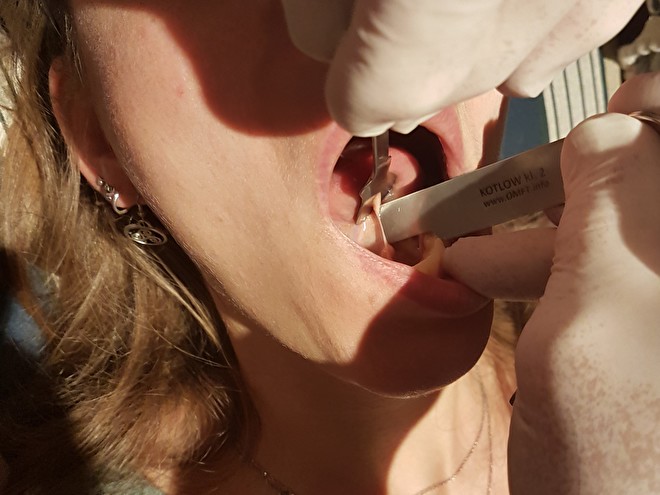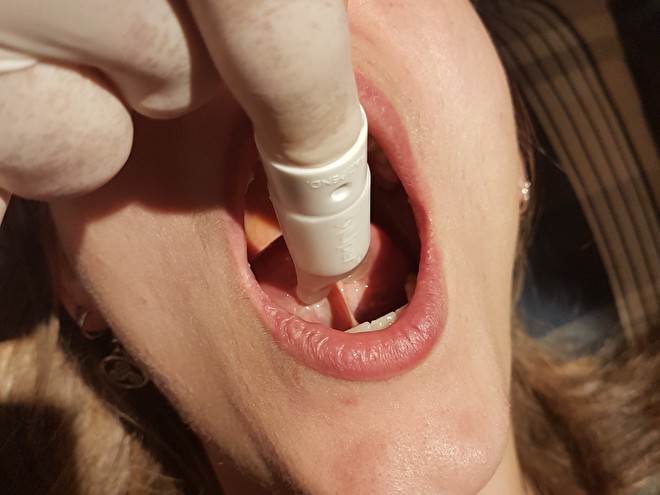Tongue ties
The position of the tongue at rest is the most important factor that determines the shape of the upper jaw. For example, a narrow palatum is mainly determined by a low tongue position at rest. This also affect the growth direction of the entire face. A low resting position of the tongue will therefore often result in a vertical growth direction (see Vertical growth of the face).
A low tongue position is very often caused by a too short or too stiff tongue tie. By performing clack and suction exercises, the upward force of the tongue will improve and the flexibility of the bottom of the mouth will increase, eliminating the need for surgical intervention by means of lasering or electrosurgery. Still it often is necessary that the tongue tie has to be removed or cleaved, because the short tongue tie permanently obstructs the normal position of the tongue. An English pediatrician, Lawrence Kotlow, has given guidelines for this: lengths of the tongue tie where intervention is required, when it may be necessary and when not. These guidelines are known as the Kotlow classification.
Lawrence Kotlow, however, only measures the distance from the tip of the tongue to where the tongue tie is attached to the bottom of the tongue. Measuring the length of the tongue tie is also of importance within the oro myofunctional therapy (OMFT). For doning both measurements there are special tools available: the Kotlow rulers and the grooved director or the Tongue Guide Pro. The tongue is raised with the grooved director or the Tongue Guide Pro, after which the length of the tongue tie can be determined by choosing the correct Kotlow ruler. The distance from the bottom of the tongue to the top of the saliva caruncula is the distance to be measured,
OMFT.info has developed the Kotlow rulers itself; handy and actually indispensable to quickly and properly determine when a referral must be made for correction of a tongue tie.


Measuring the tongue tie with the Kotlow ruler and grooved director (left) and using the liper device (right).
Correcting the tongue tie?
Experience shows that intervention is usually not necessary for a Class 1. In a Class 2 intervention may be necessary, but sometimes OMFT exercises can achieve more flexibility in the bottom of the mouth and motr strength in the tongue, making it possible to learn a good tongue position at rest and while swallowing. With a Class 3 and 4 exercises will be insufficiently successful and intervention by means of a frenlectomy or frenulotomy is necessary. Lawrence Kotlow says about this:
When determining the need to revise the frenum in infants and children, the following guidelines are suggested:
- The lingual attachment should not create a diastema (gap) between the lower front teeth.
- The lingual attachment should not cause excessive force on the lower front teeth causing them to tip backward.
- The lingual attachment should not cause severe blanching of the gum tissue behind the lower front teeth.
- The lingual attachment should not prevent a normal swallowing pattern. The tongue should be able to lick the lips and allow the tongue to clean the tooth surfaces after eating.
- The lingual attachment should not prevent a normal swallowing pattern. The tongue should easily touch the roof of the mouth.
- The lingual attachment should not cause abrasion to the underside of the tongue.
- The lingual attachment should not interfere with certain eating pleasures.
- The lingual attachment should not interfere with certain social activities.
- The lingual attachment should not affect the speech.
After the tongue tie has been corrected, the place where the tongue tie has been should be regularly massaged to prevent adhesion of the wound edges. This is very easy with a liper device or a Tongue Guide Infant Home.
Developed by OMFT.info
 Kotlow ruler
Kotlow rulerA set of rulers to measure the tongue tie and determine the Kotlow classification. After this, it can be determined whether it is necessary to remove or cleave the tongue tie.
€ 21,25 Tongue Guide Pro (for professional use)
Tongue Guide Pro (for professional use)Instrument for raising the tongue and tensioning the tongue tie while measuring the Kotlow classification or performing a surgical procedure.
€ 15,50 Tongue Guide Infant Home (for use by parents)
Tongue Guide Infant Home (for use by parents)To stretch the area under the tongue after surgical correction of the tongue tie, so that the wound heals well and there is no relapse.
€ 6,75Adapted for OMFT
 Grooved director
Grooved directorRounded instrument to easily hold the tongue back and tighten the tongue tie (while measuring the Kotlow classification of the tongue tie with the Kotlow ruler).
€ 9,95 Tongue Gym (Liper device)
Tongue Gym (Liper device)Usefull while measuring the Kotlow classification and to stretch the place where the tongue tie has been after a surgical correction (to prevent adhesion of the wound edges).
 Alcohol 96% (250 ml)
Alcohol 96% (250 ml)Alcohol for disinfecting OMFT instruments (spiritus ketonatus dilitus, 96%). Available in a bottle of 250 ml.
€ 4,50
Shopping cart
Contact
OMFT.info
Liset Maas-Houtekamer
info@omft.info
www.omft.info
www.webshop-omft.info
+31 (0)6 55 956 582
Chamber of Commerce: 20154851
VAT: NL001753845B84
Bank: NL81 INGB 0001.9157.67
Terms and Conditions



